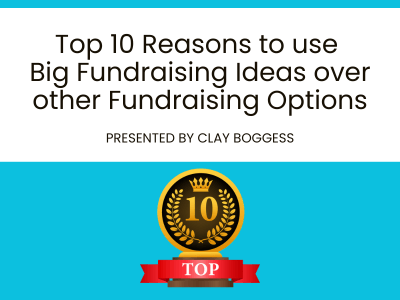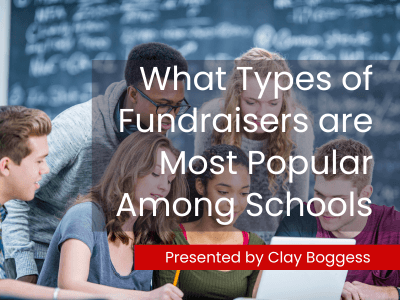
What schools should focus on to raise more money.
You might think this is a trick question. Of course, everyone would want a higher fundraiser profit if given a choice. To be clear, this is not about how much money you take to the bank. That is often referred to as the 'net profit' amount. It should be in everyone's best interest to desire to raise as much money as possible.
Instead, we're talking about 'profit percentage', where a school does a popcorn fundraiser, for example, and makes 40% of the gross sales. There are two ways that profit percentage is usually established for groups.
One way is based on order volume. This is where a group may order a product up front and turn around and sell it for a profit. Companies offer price breaks to groups for ordering more products. So if the group is willing to place a larger order, they'll get to keep a higher percentage of the gross retail. These 'volume discounts' are already established and can't be negotiated.
In other cases, schools may be able to negotiate how much they make off of each sold product. This is more common with brochure fundraising, where the group takes product orders first, then submits their order to the company for processing.
It's not uncommon for a PTA board to only work with one company because they offer them a higher profit than another. Sounds logical. What group in their right mind wouldn't want to have the potential to make more money off each item?
If you follow this line of thinking to the extreme, why can't a group negotiate 60% or even 70% profit? Well, it doesn't take a rocket scientist to figure out that when two parties are involved in something, there must be a compromise. The company must also make money to stay in business and offer a service. In other words, both sides need to win.
Yet, schools ultimately have a choice. They can always build their fundraiser from the ground up and keep most, if not all, of the profit. This is usually a lot more work, and many groups don't have the time or the energy. So for the sake of argument, we will assume that this is off the table.
So why would groups not attempt to force the company's hand and say something like, "We'll work with you, but you have to give us more profit first."? Some schools can throw their weight around by leveraging their previous sales history. Higher volume schools tend to get more profit percent because the overall pie is more significant.
But what are schools giving up in exchange for that higher profit percentage? It turns out more than they think. Let's look at one compromise that you may not be aware of, company incentive plans.
How School Fundraising Incentives Work
Older students aren't as motivated by the traditional prize programs offered by many companies as their younger peers are. Thus, high school sponsors often search for new and better incentive ideas to inspire their group to sell and increase sales.
Learn why fundraiser prize programs need an overhaul
Older groups seem to be responding to two incentive plans: our cash and sportswear prize programs. These prize incentives offer a refreshing alternative and appear more suited to high school organizations like sports teams or cheerleader groups.
Traditional prize programs are the least expensive option that companies have in their arsenal, and thus they have the flexibility to offer more profit. Yet group sponsors struggling to get more students to participate may need more enticing alternatives.
It's also fair to mention that some sponsors may attempt to negotiate a high-profit percentage by forgoing the prize program. They often feel that there is already intrinsic motivation for their group members to sell without the need for extrinsic incentives. Our experience is that this strategy has been proven over time not to work. We've found that most of these sales typically underperform.
Even elementary schools benefit from better prize programs. We looked at the results of several schools that earned a higher profit percentage using a cheaper traditional incentive plan. Then they switched to a better prize program the following year in exchange for a lower profit percentage. Schools raised more money with the superior incentive plan 100% of the time. And the sales increases were significant.
Fundraiser Profit vs. Participation
So perhaps the most critical question that needs to be asked is, "How much money can our school raise?" In other words, groups need to focus on maximizing gross retail dollars, not just how much profit they make from each item sold. It can be argued that schools that focus primarily on negotiating a higher profit percentage tend to put less emphasis on doing things that will strengthen their fundraiser.
More robust prize programs and effective promotional strategies have been proven effective in boosting overall sales and must be foremost in the minds of sponsors. Improving school fundraising participation is vital to putting more money in your coffer.
Ask yourself this question. If you had to choose, would you take a higher fundraiser profit percentage or more student participation? If you don't have your students on board, how much profit you make off what you sell won't mean as much.
Why fundraising profit percent is overrated
One way to improve participation is to offer better-quality prize programs. The prizes at the lowest levels must be much more appealing to get more students off the fence. But at the same time, the higher-level prizes need to be able to keep the students selling even more items.
The additional items sold should more than offset the lower profit percentage.
Student participation is a critical component of fundraising. Therefore, it may be worth accepting a slightly lower profit to get more students to sell.
Learn how to build support for your product fundraiser
Ultimately, schools should be more concerned about how much money they bring in by offering better incentives and less on fundraiser profit percentage.
What would you do if you had to choose?
Author Bio
Clay Boggess has been designing fundraising programs for schools and various nonprofit organizations throughout the US since 1999. He’s helped administrators, teachers, and outside support entities such as PTAs and PTOs raise millions of dollars. Clay is an owner and partner at Big Fundraising Ideas.



